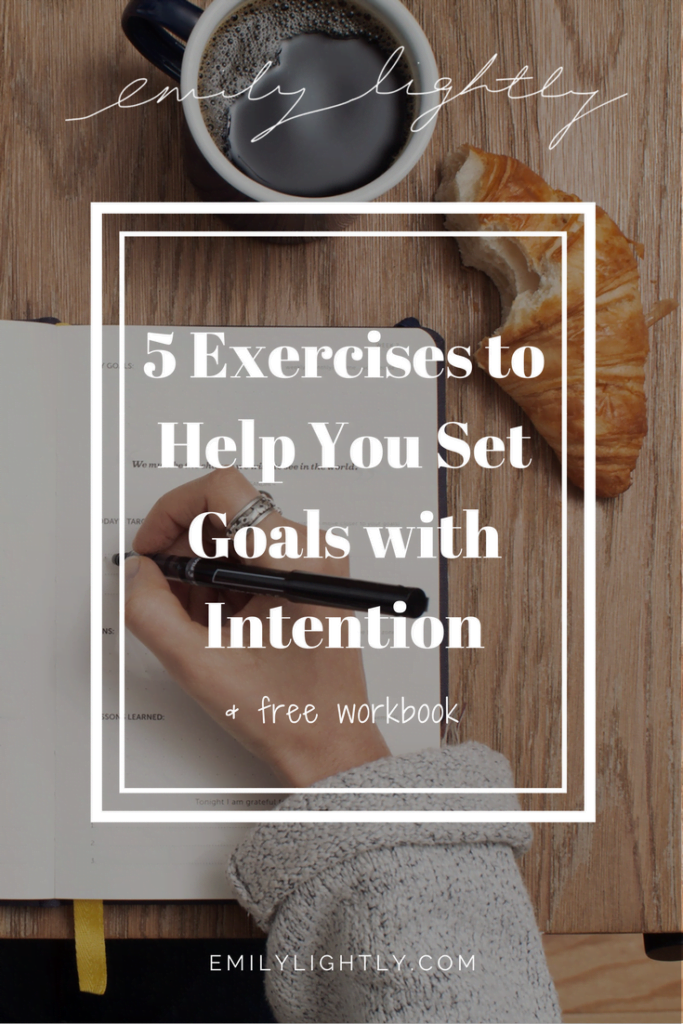Firstly, I know I am a little late in saying this, but – happy new year! I hope 2018 is off to a great start for you. Have you set goals or resolutions for the year ahead? If so, how are they going (and if not, are you planning to?)
Whether you’ve made resolutions or not, the start of a new year is always a great time to identify, set, and plan some goals for the next year. If you don’t have any goals for 2018, then this post is a great read to help you get started! And if you do, I hope these exercises will still be useful to you in terms of prioritizing your goals and making sure you’re working towards what you want in your life.
You might be wondering, how does this relate to simple living? Well, it falls under one of my five pillars of simple living: personal development. I believe the key benefit of living more simply is not just reducing clutter in your life – be it physical or emotional – but what happens once that clutter is gone. Suddenly, you have all of this space in your life; what do you replace it with?
Maybe you know the answer already, but it’s okay if you’re left wondering what to fill your life with after getting rid of everything that was dragging you down. These five exercises should help you identify and prioritize your goals for the year ahead, allowing you to design the life of your dreams with a little more intention.
Are you ready to set goals with intention now? If so, make sure you grab your FREE copy of the Goals with Intention Workbook. It will take you through each of these exercises as well as give you a planning worksheet to ensure success for each goal that you set.
Exercise 1: Two Lists
The first exercise is to make two lists. One should contain aspects of your life as it stands now. Think of all parts of your life, including your career, relationships, health and fitness, etc. Write down a list describing these aspects of your life to get a good sense of where you’re currently at.
In the second list, write down those same aspects, but describe them as if you were living your ideal or dream life. Take the time to think about what’s really important to you and what would make you the happiest.
Now, compare those two lists side by side and note how they differ. Set goals that will help you work towards closing those gaps between your current and ideal state.
Exercise 2: Visualize Your Ideal Life
Visualization is an amazing way to solidify goals in your mind and stay motivated. Sit or lie in a comfortable position, close your eyes, and imagine yourself achieving a goal, or just a regular day in your life if you were living your ideal life. Focus on imagining what steps you took to get there and how it finally feels to be living the life you’ve always imagined.
You can stick to just visualizing this in your mind, but I’d also recommend writing it down on paper and keeping it. Try writing it as if it were a diary entry for a day in your ideal life. You can then go back to it any time you need some extra motivation.
P.S. For more tips on how to stay motivated, check out this article.
Exercise 3: Problems and Solutions
This is a really great exercise if you’re feeling stuck in a particular area of your life. First, write down what you see as a ‘problem’ in your life – basically, an aspect of your life that you’re not fully happy with or that is causing you stress or other negative emotions.
Now for that one problem, brainstorm and write down every single solution that you can think of. Try to keep them realistic. For example, one problem could be that you don’t feel like you have enough money, and it’s causing you a lot of financial stress. Potential solutions for this problem could be:
- Reducing your expenses (cutting back on spending, buying less expensive items, cancelling subscriptions, etc.)
- Finding a higher paying job or taking on a second job
- Making a personal budget to track finances & limit spending in different categories
- Winning the lottery (not very realistic!)
- Using your skills to make some extra cash on the side
After you’ve thought of every solution you can, take a look at your list and determine which solution works the best for you. What are you willing and able to do in order to solve this problem in your life? Choose a solution and make that your goal.
If you have a problem to which it seems there’s no solution, I’d recommend two things. The first is asking a friend or someone you trust for their advice and seeing if they can come up with some ideas. The second is that if there really doesn’t seem to be a solution for this problem, accept that there are some things we can’t change in our lives. Even if you can’t completely solve a problem, there might be a way to improve it slightly and relieve some of the negative consequences.
Exercise 4: Proof
Making specific, realistic, and achievable goals is a must if you want to actually achieve them. This exercise is helpful if you want to make your goals more specific and determine what steps you need to take to get there.
For this exercise, think of a goal you have and consider what kind of ‘proof’ you’d ask for in order for someone to say they’ve achieved it. What is the criteria, and how will you know when you’ve reached your goal?
An easy example is if you’re looking to lose weight – your proof would be your goal weight. Once you reach that weight, you have the proof that yes, you’ve achieved your goal. You can then put that goal into your achieved pile, or re-evaluate and set a new one for that area of your life.
For the sake of having another example, let’s say that you want to work on a new hobby in 2018, maybe writing. What proof would you ask for if someone told you that they had improved their skill in writing this year? Maybe you’d like to see that they had spent at least 1 hour a day, every day working on writing exercises. Or maybe it’s that they’ve successfully had an article published in the news or a magazine. This proof then becomes your actual goal, so instead of it being very general and flimsy – improve writing skill – it is now very specific and achievable: practice writing for an hour each day.
The point of this exercise is to find something measurable when it comes to your goal. By doing this, it’s a lot clearer what steps you need to take to work towards it. It will also make it very clear when you’ve achieved your goal and can reward yourself for all of your efforts!
Exercise 5: Areas of Your Life
Finally, the last exercise is meant to help you determine with areas of your life you should focus on when you set goals.
The first step is to consider each area of your life one-by-one and determine how fulfilled you are in that area. The categories can include (but aren’t limited to):
- Health (physical, emotional, and/or mental)
- Family & relationships
- Travel
- Finances
- Career (or education)
- Hobbies & skills
- Personal development
Feel free to break the categories into more specific areas or add ones to best reflect your life.
In each area, write down what makes you happy and fulfilled, perhaps what you’re grateful for, and what you wouldn’t want to change. Considering all of those things, now think about what might be missing from that area of your life.
Maybe one area has you completely content, or it might just not be a priority for you right now. But by going through your life, category by category, it will show you those areas that might need a little more TLC than others to make you feel more content and fulfilled overall.
Join our simple living family!
Subscribe now to get tips on simple living, minimalism, personal development, capsule wardrobes & more delivered to your inbox. You’ll also receive a free copy of 5 Steps to a Simpler Wardrobe, a quick and easy guide for decluttering your closet and streamlining your style!
I hope you enjoyed reading this article and found it helpful! I’d love to hear some of your favourite tips for setting goals in the comments below.
Until next time,
Emily xx
Featured photo by Cathryn Lavery on Unsplash
Pin for later:


